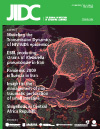Chronic hepatitis B infection in a hepatology clinic at a university hospital in Jeddah
DOI:
https://doi.org/10.3855/jidc.751Keywords:
Serum ALT, natural history, vaccination, HBV-DNA, PCR, ultrasound, liver cirrhosisAbstract
Introduction: The outcome of chronic hepatitis B (CHB) infection in a cohort of CHB patients at the hepatology clinics of King Abdul Aziz University Hospital in Jeddah was studied.
Methodology: The results of a complete blood count, prothrombin time, liver function test and hepatitis B virus polymerase chain reaction (HBV-PCR) performed over the previous two to five years of follow-up were reviewed. Results of abdominal ultrasound performed within the last year and the data on the treatment type, duration and resistance were also obtained.
Results: The majority of the 109 patients studied were Hepatitis B e antigen (HBeAg-negative; 87.2%). Male patients had higher serum ALT values compared to females at follow-up. HBeAg-positive patients had higher HBV-PCR levels at diagnosis compared to HBeAg-negative patients. Patients below 40 years of age had higher HBV-PCR compared to those above 40 years. Ultrasound showed liver cirrhosis in 11% of patients. Cirrhotic patients had higher GGT levels compared to non cirrhotic patients. Drug resistance developed in 25% of the 20 Lamivudine-treated patients. The mean duration of treatment was 2.5 ± .47 years.
Conclusion: CHB was predominantly HBeAg negative, with a benign long-term outcome in most patients. Therapy may need to be individualized for patients with high risk of progression.
Downloads
Published
How to Cite
Issue
Section
License
Authors who publish with this journal agree to the following terms:
- Authors retain copyright and grant the journal right of first publication with the work simultaneously licensed under a Creative Commons Attribution License that allows others to share the work with an acknowledgement of the work's authorship and initial publication in this journal.
- Authors are able to enter into separate, additional contractual arrangements for the non-exclusive distribution of the journal's published version of the work (e.g., post it to an institutional repository or publish it in a book), with an acknowledgement of its initial publication in this journal.
- Authors are permitted and encouraged to post their work online (e.g., in institutional repositories or on their website) prior to and during the submission process, as it can lead to productive exchanges, as well as earlier and greater citation of published work (See The Effect of Open Access).








